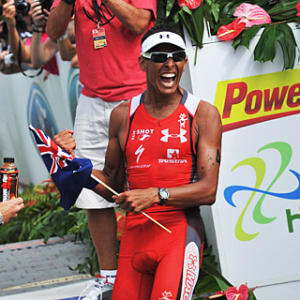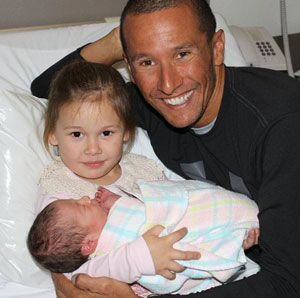I’m Here to Win

Publisher’s note: Below is an excerpt from the just-released book by Chris McCormack: I'm Here To Win: A World Champion's Advice for Peak Performance, available at Amazon.com via the highlighted link.
I get asked all the time about my typical training week, and my answer is always the same: there is no typical training week. I build on what I call a skeleton, but the specifics are based on how I feel that week. That’s why I’ve gotten the “fluffy” label. Everybody else thinks you set a routine and then gut through it no matter how tired you are or how much you hurt. That’s not how I do things. I listen to my body, and that’s why I don’t get injured.
I have a certain structure I like to follow. On Monday, I’ll do strength work on the bike. I tend to work off one key session per day. Think of your skeleton as one key session every day. That’s the one thing you’ve got to do. If, after you do it, you’re wiped out, drop the rest of the work you had planned for the day. The rest is fluff.
In 2010, I was looking to develop my bike strength and fix up my swim. I knew that the swim had to be rectified at the beginning of the swim session. I needed to get a good start, be fast enough, and build my lactate tolerance. So I added an extra swim set to the mix on Tuesday, something I never used to have. It was very speed intensive, and I did it first thing in the morning. Normally, early-morning swims are a problem for me. By the time I wake up, the session is nearly done. I turn up at the pool early with everybody else, get in, and just start going through the motions. I’m doing the coach’s set, because I’ve informed my coach that I want speed from this set. I want lactate tolerance work. But by the time I’ve woken up I’m three kilometers in, and I only have two kilometers to be in the groove. So I started changing my sleep habits and starting focusing on that Tuesday session.
The skeleton works off the assumption that if you were to do just this as your bare minimum, you would survive and finish your race. For any athlete, you establish the skeleton based on how much time you have, what’s happening in your life, and what kind of race you’re preparing for. Then you build your body around it.
One key to training this way is to attach no guilt to it. You have to let go of the numbers. Stop counting how many miles you did at the end of the week! You have to train yourself to be confident that you are doing enough and stop overtraining as a security blanket.
Another key is establishing a skeleton that’s suited to what you’re after in your race. Are you looking at finishing? Are you trying to win? If you’re an age grouper doing an Ironman, your training goals are going to be very different from mine. You might be hoping to finish in less than fifteen hours; I’m looking to finish first in around eight hours. So a strength set for me will probably be very different than a strength set for you. (Take a look at my skeleton-building foundation below and pattern yours around it with the help of your coach.)
That approach didn’t endear me to sports scientists or coaches. According to them, success was all about training according to a hard-and-fast routine. I was the guy in the classroom who hears the lecture, then puts his hand up at the end and says, “That’s all bullshit.” In a way, I was discrediting their whole field, and to make it worse, I was winning. If a coach isn’t writing programs for people, then what’s he good for? But I think coaches are more important than ever, provided they can adapt along with their athletes and have a relationship with them that recognizes what’s unique about each one.

For example, some coaches have sixty or seventy athletes and send out a generic training program for all of them. In light of what I’ve just said, that’s insane. What works for one athlete might permanently damage another. I’d like to see more athletes question poor race results; you almost never see that. The coach is in the perfect position: he gets credit for the successes but no blame for the failures. The athlete always blames himself. I’d love to see athletes start asking, “Well, Coach, what happened?” Once there’s accountability, there will be change.
I think this is a major reason that rest is the most underrated thing in our sport. The perception is that you don’t need a coach to rest. If you’re a coach, you’re paid to develop these elaborate training strategies with just the right arrangement of bricks, time trials, strength work, and the rest. The thing is, a good coach knows when an athlete should rest, how much rest he should get, and what he should do coming out of a rest day. Rest, like every part of our training, is strategic.
What many athletes don’t understand is that you don’t gain strength on the bike. You don’t gain strength lifting weights. You gain strength sitting on the couch watching TV after your workout is done. When you exercise, you damage your muscles. You repair that damage during rest and sleep. That’s when the important changes happen. That’s why I rest as much as I do. If you want proof that it works, look back at my Drummondville race in 1996. I rested the entire week and destroyed the field. But in the Ironman world, I get called “fluffy” because rest is not macho. I just say, look at my results.
When you’re building your training skeleton, start by planning your time. You are doing three sports. You’ve got to fit in a lot of training. If you’re also working a full-time job, time is precious. The difference between a professional and an amateur triathlete is that pros have more time to train and rest.
—
From I’M HERE TO WIN: A World Champion’s Advice for Peak Performance, available at Amazon.com via the highlighted link. by Chris McCormack with Tim Vandehey. Copyright © 2011 by Chris McCormack. Reprinted by permission of Center Street, New York, NY. All rights reserved.




Start the discussion at slowtwitch.northend.network